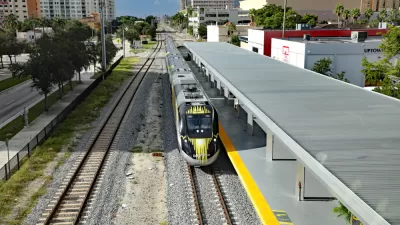The San Francisco Peninsula stretch of the LA-SF high speed rail line appears to be stirring up as a classic debate between suburban San Mateo and Santa Clara Counties.
The High Speed Rail Authority held a meeting in San Francisco on August 5 to release its alternatives analysis - a necessary environmental planning document that shows the possible configuration of the tracks for the section between San Jose and San Francisco along the existing Caltrain commuter railroad right-of-way. A four-track alignment along most of the 50 miles would be shared by commuter, freight, and high-speed rail.
"The divisions between those calling for full speed ahead on the $43 billion California high-speed rail project and dissenters were on full display. Mayors and city council members from Burlingame, Belmont, Palo Alto, Atherton and Menlo Park joined together in the Peninsula Cities Consortium, and issued a clarion call this month that the San Francisco-San Jose leg of the project should be "built right or not at all," prompting accusations of "obstructionist policies" from Jim Wunderman, CEO of the Bay Area Council (business group)."
"Gabriel Metcalf, executive director of the San Francisco Planning + Urban Research Association (SPUR), went further. He described California high-speed rail having "national, even international significance." Given those stakes - necessary community involvement and input notwithstanding - "It's impossible to address every single individual concern. It's an impossible wish," he said."
However, many Peninsula cities only appear to dig in their heels deeper to prevent an aerial track configuration they fear will do permanent harm to their cities.
FULL STORY: High-speed rail factions on display at meeting

Maui's Vacation Rental Debate Turns Ugly
Verbal attacks, misinformation campaigns and fistfights plague a high-stakes debate to convert thousands of vacation rentals into long-term housing.

Planetizen Federal Action Tracker
A weekly monitor of how Trump’s orders and actions are impacting planners and planning in America.

In Urban Planning, AI Prompting Could be the New Design Thinking
Creativity has long been key to great urban design. What if we see AI as our new creative partner?

Florida Seniors Face Rising Homelessness Risk
High housing costs are pushing more seniors, many of them on a fixed income, into homelessness.

Massachusetts Budget Helps Close MBTA Budget Gap
The budget signed by Gov. Maura Healey includes $470 million in MBTA funding for the next fiscal year.

Milwaukee Launches Vision Zero Plan
Seven years after the city signed its Complete Streets Policy, the city is doubling down on its efforts to eliminate traffic deaths.
Urban Design for Planners 1: Software Tools
This six-course series explores essential urban design concepts using open source software and equips planners with the tools they need to participate fully in the urban design process.
Planning for Universal Design
Learn the tools for implementing Universal Design in planning regulations.
Gallatin County Department of Planning & Community Development
Heyer Gruel & Associates PA
JM Goldson LLC
City of Camden Redevelopment Agency
City of Astoria
Transportation Research & Education Center (TREC) at Portland State University
Jefferson Parish Government
Camden Redevelopment Agency
City of Claremont



























